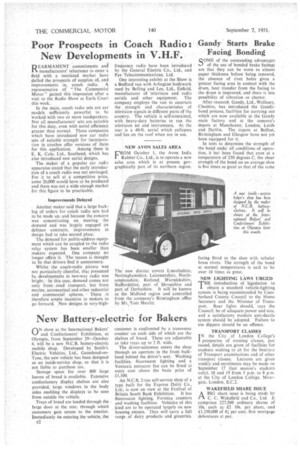Poor Prospects in Coach Radio: New Developments in
Page 38

If you've noticed an error in this article please click here to report it so we can fix it.
REARMAMENT commitments and I% manufacturers' reluctance to enter a field with a restricted market have dulled the prospects of supplies of, and improvements in, coach radio. A representative of "The Commercial Motor" gained this impression after a visit to the Radio Show at Earls Court this week.
In the main, coach radio sets are car models sufficiently powerful to be worked with two or more loudspeakers. Not all manufacturers' sets are suitable for this duty, even with aerial efficiency greater than normal. Those companies which have introduced new car radio sets of suitable strength for incorporation in coaches offer versions of them for this application. Among them is E. K. Cole, Ltd., Southend, which has also introduced new aerial designs.
The maker of a popular car radi3 apparatus stated that the early introduction of a coach radio was not envisaged. For it to sell at a competitive price, some 20,000 would have to be produced and there was not a wide enough market for this figure to be practicable.
Improvements Delayed Another maker said that a large backlog of orders for coach radio sets had to be made up, and because the concern was concentrating on meeting the demand and was largely engaged on defence contracts, improvements in design had to take second place.
The demand for public-address equipment which can be coupled to the radio relay system has been smaller than makers expected. One company no longer offers it. The reason is thought to be that drivers find it unnecessary.
Whilst the coach-radio picture was not particularly cheerful, that presented by developments in two-way radio was bright. In this case, demand comes not only from road transport, but from marine, aeronautical and other industrial and commercial spheres. • There is therefore ample incentive to makers to go forward. New designs in very-high frequency radio have been introduced by the General Electric Co., Ltd., and Pye Telecommunications, Ltd.
One interesting exhibit at the Show is a Bedford van with Arlington bodywork used by Belling and Lee, Ltd., Enfield, manufacturer of -television and• radio aerials and other equipment. The company employs the van to ascertain the strength and characteristics of television signals in different parts of the country. The vehicle is self-contained, with heavy-duty batteries to run the television set and instruments. At the rear is a 40-ft. aerial which collapses and lies on the roof when not in use.
























































































